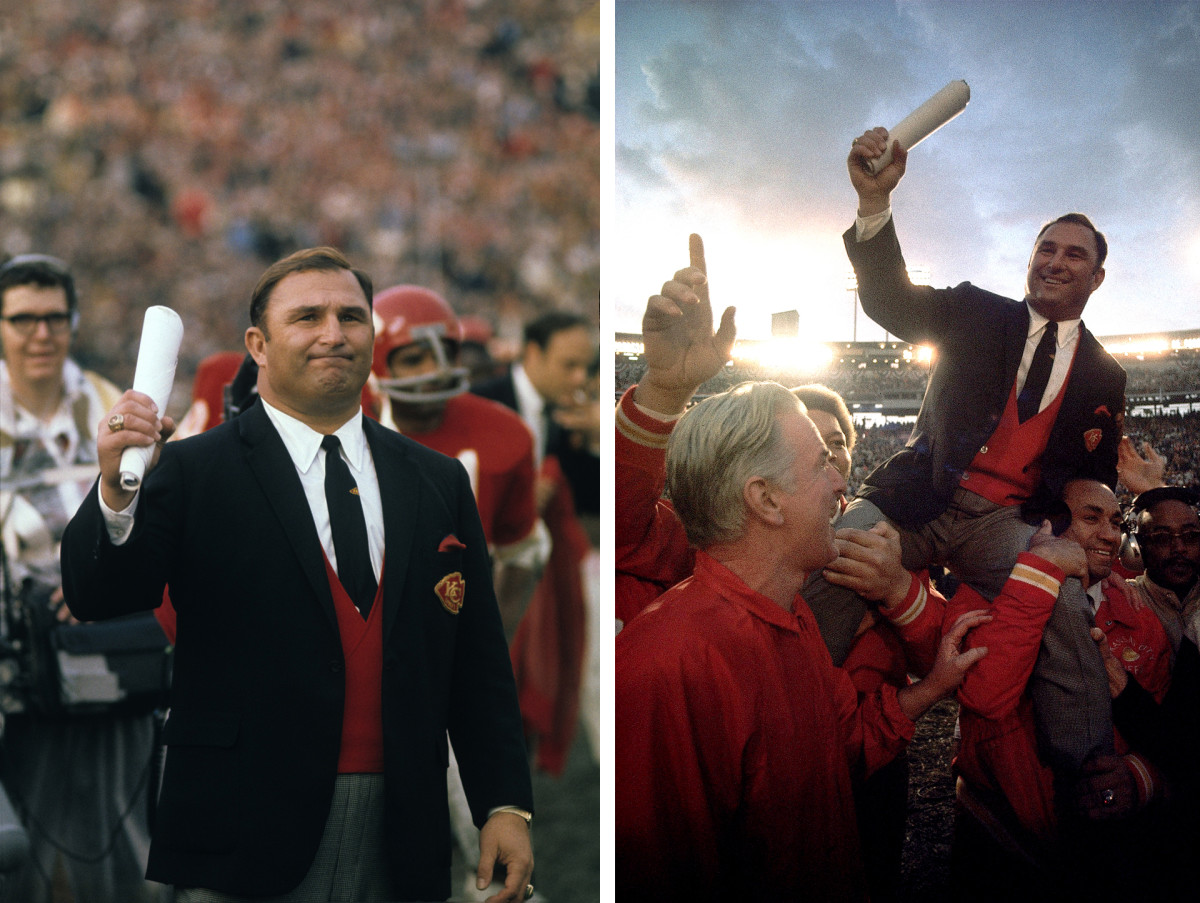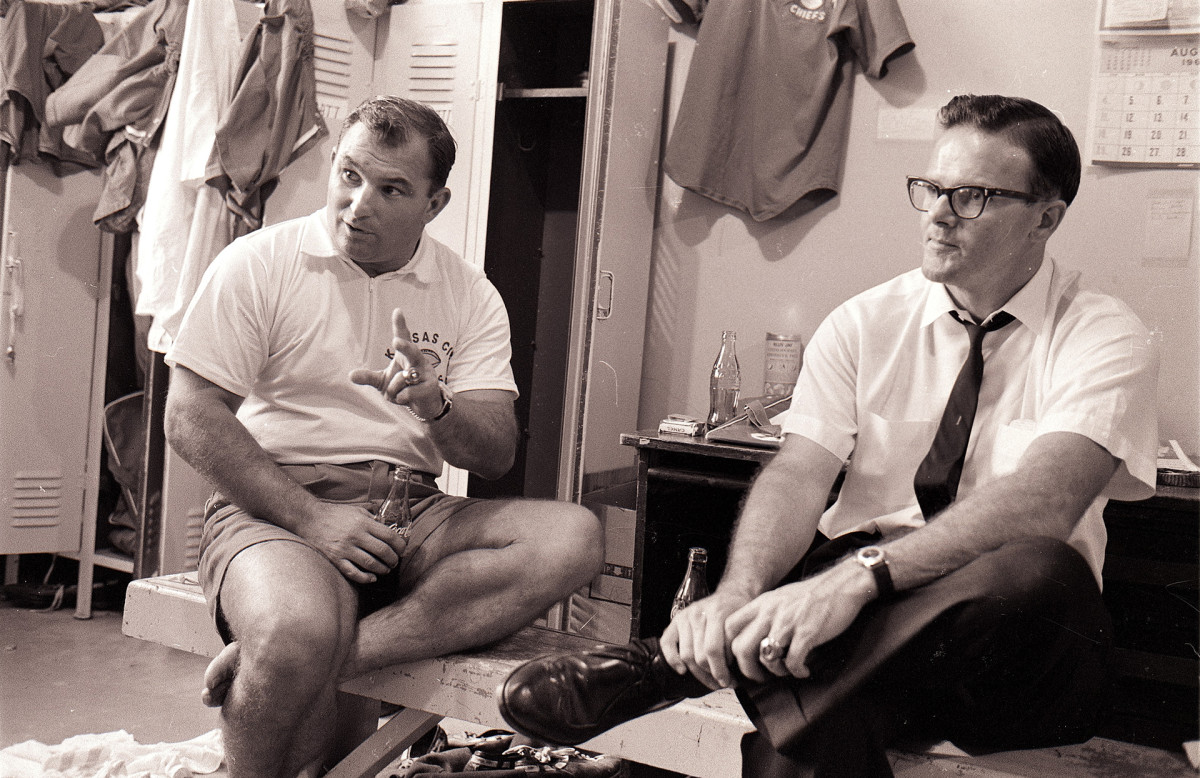The Madness of Super Bowl IV, and the Play—65 Toss Power Trap—That Defined It

MIAMI — He would think of these ideas while floating in the backyard pool. The kids would later joke, lovingly, that Hank Stram was coated in so much tanning goop that it looked like a small oil spill was encircling him there on the raft. But these sessions would end up producing some of the most important schematic advances in football history. The moving pocket. The I formation. Perplexing backfield motion. And, of course, the infamous 65 Toss Power Trap, which, until the Chiefs touched down at Super Bowl LIV this week here in Southern Florida, may have served as the single most memorable moment in franchise history.
The play—a fake toss sweep coupled with an inside handoff to running back Mike Garrett at the end of the second quarter—sealed the franchise’s first and only Super Bowl win, over the Minnesota Vikings back on Jan. 11, 1970. Like a catchphrase in a popular movie, it became larger than the moment. The same could be said about its inventor, who, after that game went from affable head coach to football icon.
The lasting legacy of Stram and the Toss Power Trap—a call that resulted in a five-yard touchdown in a game that was decided by 16 points—is even more impressive considering just how wild their Super Bowl experience was. Thanks to Steve and Ed Sabol of NFL Films having the foresight to hook Stram up to a microphone, we remember the play and the way Stram called it. We remember Stram whipping up and down the sidelines saying things like “keep matriculating the ball down the field” (another phrase that became so popular, those who know Stram joke, that it changed the meaning of the word “matriculation,” which is supposed to describe the act of entering a university).
What we remember less are storylines that, by today’s standards, would have swallowed the Super Bowl whole. The Tuesday before the game, Stram’s star quarterback, Len Dawson, had been mentioned in a federal gambling investigation. Before the game started, a hot air balloon containing the Vikings’ mascot blew into the air and crashed into the stands. It was the end of a turbulent year in American history; the end of a long season for Chiefs players who had been through an entire season’s worth of Stram’s legendarily ruthless practices and post-practice mile-long sprints.

And yet, here was Stram, the picture of cool holding it altogether; somehow able to both keep his underdog team in harmony and exude the kind of outward cool that helped professional football keep lasting attention on their budding brand.
“Dad was everything that team was,” Stram’s son Dale said. “He was colorful, imaginative. He was disciplined. He was all of these things. And the team reflected him. Dad was a great salesman.”
Here was a play that, even as the current Chiefs dug in for their first Super Bowl appearance since 1970, was still fresh in their minds.
“If I knew how to run it I would,” head coach Andy Reid said of 65 Toss Power Trap, less than a week before the Super Bowl. “What a great play.”
* * *
The night that gambling allegations against Dawson broke on NBC News, commissioner Pete Rozelle sparked a cigarette and corralled all of the country’s biggest sports reporters behind the credential desk at the league’s New Orleans headquarters to swing back against what the league believed was an erroneous story (Dawson was never formally charged). It was a massive undertaking at the time, pushing back against the heft of a network news report, trying to protect the legacy of a league that was still infantile by American standards.
“It was one of very few times I saw Rozelle lash out at any media,” Joe Browne, a long-time league office employee said of Rozelle’s tense phone calls with NBC before calling the press conference.
Around that same time, Stram was showing no signs of stress. He was helping devise a strategy that would hide the star quarterback in different hotel rooms (and sometimes his own) in order to protect Dawson from the horde of press looking for a comment. Jan Stenerud, then the team’s placekicker, remembers Stram announcing the allegations to the team in a private meeting, which set off a chain reaction of loud, impassioned defenses of Dawson from some of the team’s oldest players. From there, the issue seemed to evaporate from their consciousness.
Fifty years later, Stenerud said it seemed as if Stram had planned it that way, riling up the team’s elder statesmen in order to obscure the controversy surrounding their most important player.
“He probably prodded them to do it,” he said. “There was no doubt at all, no one wondered if, Hey, well maybe this could be happening. The minute we left that room, there was nothing.”

If there is one common thread in the myriad remembrances of Stram, it is a strange ability to handle everything, all at once with a flourish, like everyone else was the mark in his very own heist movie. Stram operated in a time before coaching staffs were the size of White House administrative networks, which meant that everything in his orbit commanded (and got) his personal attention, despite the insurmountable time crunch. A gambling scandal rattling his star quarterback and field turf conditions that bothered his kicker seemed to get equal, loving care. In the moments when it might feel like Stram was too preoccupied, he’d seemingly appear from nowhere.
That was true of another one of Stram’s sons, Stu, who was told at the beginning of the week that he wouldn’t be coming to the Super Bowl. He was disappointed but understood. Then, in the moments before the team plane departed for New Orleans, Stram showed up in Stu’s Briarwood grade school cafeteria with a packed suitcase and said, “Come on, let’s go.”
“It was a highlight of my life,” Stu said. “To be able to do that on one of the most important days of his life, one of the most important games in the organization’s history, it was amazing.”
In that way, the heavily favored Vikings should have feared that someone capable of all this might also peel something devious out of his Bible-thick playbook that could sink them in the Super Bowl. Depending on which former Chiefs you talk to, the 65 Toss Power Trap was run at most three times that year. Some insist it was never run at all. Dawson would say later that the play hadn’t even been practiced in weeks.
But after building a three-field goal lead, the Chiefs began setting up the play with some wider outside toss runs to the outside. The trap run inside caught so many Vikings players out of position that running back Mike Garrett walked into the end zone untouched.
“It caught them at a disadvantage,” Garrett said. “They had a great defense and they got off the ball so quickly, so that play works against a great defense. When we faked the toss they were all on it. They’d never seen us come back with an inside trap off that.”
* * *
Today, a book full of Stram’s plays sits on a shelf at Dale’s house underneath an old Chiefs helmet and atop another book of Stram’s plays, that one from back when the organization was known as the Dallas Texans. The 65 Toss Power trap is in its rightful place, in a meticulously hand-drawn square no larger than a business card. It’s one of 12 plays under the “Sixty Left” grouping, the next page over from a glossary of all Stram’s verbiage.
So often these are the things that fade first. We remember the turbulence and the headlines. The losing seasons. The bad times. Those who knew Stram say that what stands out is the creativity and humility. The personality and the cool.
Reid is quick to point out that the Chiefs meet regularly in the Hank Stram room. The club’s production team is named after the 65 Toss Power Trap. Reid names some of the choreographed chaos he runs on offense after Stram, or other callbacks to the 1969 team that bore his resemblance.
“Our players know those things,” Reid said. “We talk about it.”

Mark Donovan, the Chiefs’ president, said that Stram and Lamar Hunt, the Chiefs’ founding owner, were drawn to each other because of their desire to do and create the unexpected. It’s not difficult to draw a line between what he saw in Stram and what Lamar’s son, Clark, saw in Reid.
“With what Hank did with offenses—I mean currently, is there a more innovative guy than Andy Reid? It’s cool to be in the middle of that,” Donovan said. “It’s coming to fruition now. I think there are a lot of similarities between the two.”
In the leadup to Super Bowl LIV, Reid managed to glide through the week and all its trappings while maintaining his own milieu that has taken on a life of its own. The affinity for a well-made, greasy cheeseburger. The high-powered offense. The donning of Hawaiian shirts.
While unintentional, there doesn’t feel like a more appropriate tip of the cap from one generation to the previous. From Reid’s attire to Stram, floating in a pool somewhere while drawing up the next great play.
• Question or comment? Email us at talkback@themmqb.com.
Super Bowl Gambling Coverage:
Complete gambling guide for Super Bowl LIV
All the Super Bowl prop bet info you need to know
Chiefs Super Bowl prop bets options and picks
49ers Super Bowl prop best options and picks
Chiefs vs. 49ers Super Bowl scoring prop bets
More From SI.com Team Sites:
49ers: Three Keys to Victory for the 49ers
Chiefs: Could Sammy Watkins Sit Out Next Season?
49ers: How the 49ers Will Contain Travis Kelce
